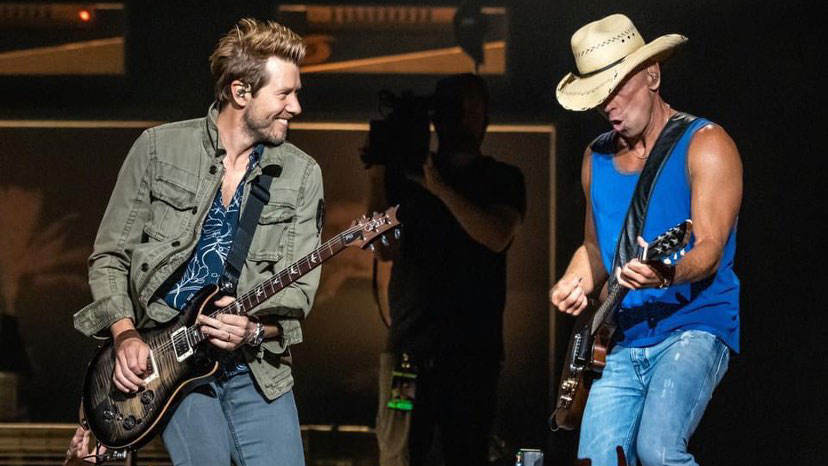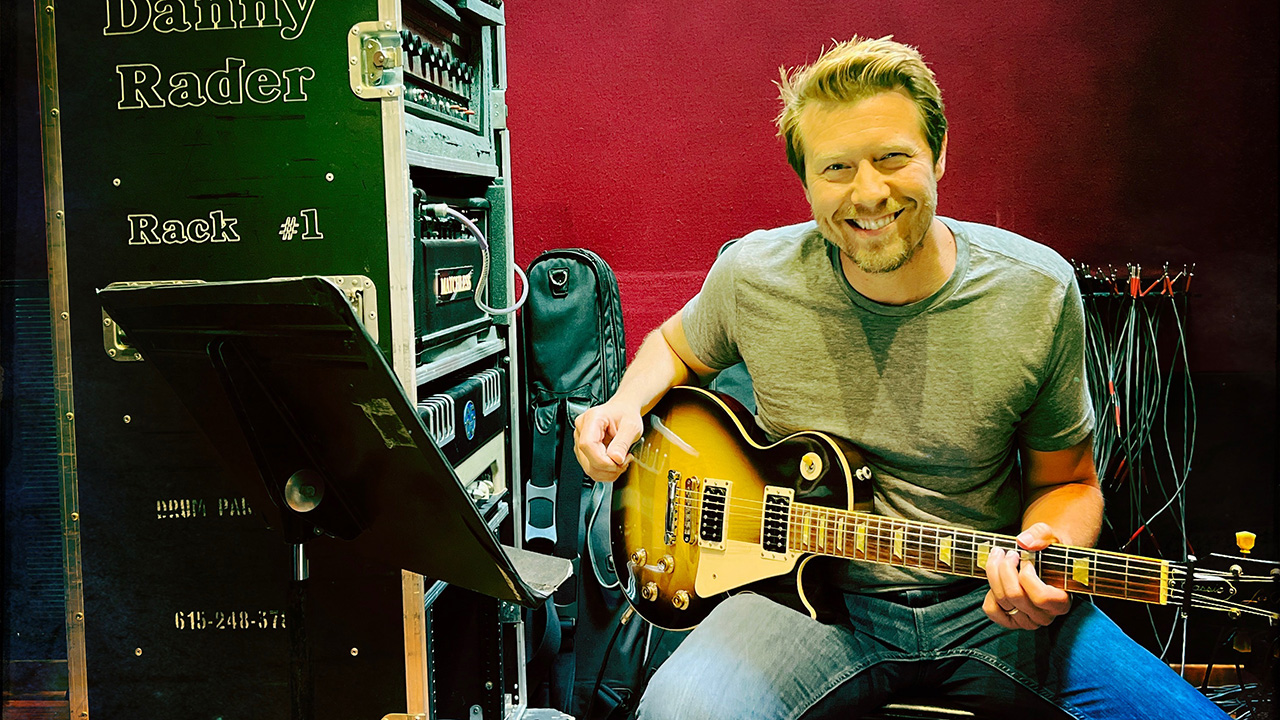“I don’t care how special or what year something is – if it’s not going to stay in tune, it’s useless… I need things dialed in”: Danny Rader on navigating Kenny Chesney’s triple-guitar lineup and why the Fractal Axe-Fx is his go-to for huge country shows
The award-winning country multi-instrumentalist discusses the fun side of playing stadium stages as part of Kenny Chesney’s “three-headed monster” – and why going digital has made his life a whole lot easier when he’s up there

A career in music was a given for Danny Rader from the moment he was old enough to hold an instrument. He grew up in Panama City, Florida, where his grandparents built the beachside Ocean Opry in 1978. For 28 years, the family – three generations, including Danny – performed there.
By the time he and his wife moved to Nashville in 2004, he was skilled on numerous instruments. His first major gig was as guitarist in country star Billy Dean’s band. He also spent 18 months polishing his engineering chops. Producer John Rich began calling Rader in for regular sessions, and he steadily added major names to his recording and touring resume.
Today, Rader is a three-time winner of the Academy of Country Music’s Musician of the Year Award (twice as Specialty Instrument Player of the Year – bouzouki, mandolin, banjo, and accordion, and once for Guitar Player of the Year).
He is the Musical Director for the Country Music Association’s CMA Awards and CMA Country Christmas, and was associate producer alongside Robert Deaton on last year’s Stoned Cold Country, an all-star country music tribute to the Rolling Stones.
In September 2023, he added another career pinnacle as music director for Ringo Starr’s induction into the Nashville Musicians Hall of Fame. “When they called and asked if I would be available to be music director for that, I said, ‘It’s a freaking Beatle! Of course!’” he says. “You tell me when and where; I’ll work it out.”
In March 2022, after 10 years on the road playing guitar with Keith Urban, Rader became a member of eight-time Entertainer of the Year award winner Kenny Chesney’s band alongside guitarists Jon Conley and Kenny Greenberg, drummer Nick Buda, bassist Harmoni Kelley and keyboardist Wyatt Beard.
Chesney has just released a new album, Born, before the band begin their 21-stadium Sun Goes Down tour. Accompanying Rader once again will be his PRS P22s, Nutter Guitars Monster (a holdover from his days with Urban), and Taylor 500 Series acoustics.
Get The Pick Newsletter
All the latest guitar news, interviews, lessons, reviews, deals and more, direct to your inbox!
Let’s begin with your guitars for touring with Kenny Chesney.
“My main go-to electrics with Kenny – and this came over from my time out with Keith – are three PRS P-22s loaded with Starla pickups. One I leave tuned down a half, and one is a backup in case I need it.
“I use the piezo pickup a lot in them, especially if I'm playing a big rhythm part, so that I can have that acoustic blended in. I send that out on its own signal to our front of house, Robert Scovill, and it’s like having two different guitars playing.
“I use Fractals so I can really nerd out on expression pedals and settings. If I’ve got a solo, the toe on the expression pedal goes down, the acoustic goes away and I boost the signal into the amp. When I put my heel back down, we’re back to where we started with the kind of brown electric sound with the acoustic blended in.
“The piezo allows me to add a nice chimey-ness and clean headroom to the electric sound, but still keeps plenty of punch. And processed separately, those can be mixed to taste out front.
“The PRS guitars play so great. I can run around the stage, jump off risers, play solos, and have the same guitar in my hand for seven songs in a row and not need to touch up tuning – not many guitars can do that when you're playing and sweating and it’s 98 degrees outside. That's one of my favorite things about those; that and the tone is so good!
We’ve got three guitar players onstage, so I don’t need a big, wide sound – I need a solid mono signal
“My approach is utilitarian in a lot of ways, in that my first and foremost concern is, ‘Does it play in tune and stay in tune?’ I don’t care how special or unique or what year something is; if it’s not going to stay in tune, it’s useless to me.
“Of course there’s tone differences and preferences beyond that, but it has to start with serving a purpose and consistency from night to night. I need things to be so dialed in that even when we don’t soundcheck, Robert can push up the fader and it sounds exactly like it did last night.”
You’ve been loyal to the Fractal Axe-Fx since the Keith Urban tours.
“I love the Fractals. I still love playing through amps on sessions, and do it whenever I can. But coming back to the utilitarian mindset, Fractals are so consistent. I’ve been with Kenny for two years, and I haven’t once seen my tech, Zeke Clark, scrambling to fix something.
“It’s so rock-solid. And I love the tweakability. I can get nerdy with specific sounds and tones, which you have to compromise if you’ve just got pedals in front of you.”
“I love the Matchless DC-30 so I’m using the Matchless sound, a Deluxe, and a Marshall. Those are the three main food groups that I start with on the amp side. I run all my acoustic stuff through the right output and all my electrics through the left. Both of them go out mono, keeping it simple.
“We’ve got three guitar players onstage, so I don’t need a big, wide sound – I need a solid mono signal. I go down the setlist and put effects in, using each song as its own preset.

“There’s a couple spots where I stay on the same preset for a few songs, but as much as the setlist changes and bounces around, I like having a preset for each song.
I changed how I perform, to a certain degree, because my interaction now is a lot through the camera guy who follows me all night
“Our gig is really old-school in that nothing is driven by SMPTE or Timecode. We only have tracks on three songs. Everything else, we count the songs off and play them, which is very rare these days.
“I’m a volume pedal guy, so I use the MFC-101 as the main switcher; and I have three expression pedals set up, one of which I always have set as a volume pedal. The other two I set up so I can program whatever I feel like for each song.
“Some of them, I have the heel position set up for my starting position, and if I need to get to the chorus. or I need a little more boost, or I want to pull some delays off and bring up the acoustic level, I can program all of that, so that when my toe goes down on that pedal, all those changes happen at once.
“As much singing as I do, I love that I don’t have to find the button to stomp at the beginning of the chorus. I can just plant my foot on that pedal, sing, and do all of that without ever having to look down.”
What are some of the challenges of stadium tours?
“The shows we grew up going to, the stuff we love watching, is based on interaction with people and building that connection so that there’s a circular energy in the room emanating off the stage and then coming back to us, as opposed to if we're just playing into the abyss.
“Kenny has some songs that evoke a lot of emotion. We added The Good Stuff back into the set last year. He hadn’t played that song in probably 15 years. It was so inspiring to see people’s reactions – you think about how many times they’ve listened to these songs, life experiences they’ve had that certain songs have ministered them through, or helped foster their relationships, and all that.
“I love having the music side dialed in enough that I can be present in the moment and be attentive when it happens.
“One of the challenges on a gig of this magnitude is when you walk up to the highest seats of a football stadium, you’re so far away that the people onstage are little dots. I realized that 98 percent of my interaction with the fanbase at these show is through the video screens.
“If I walk down to the edge of the stage and throw my hand up, unless there’s a camera capturing that, it’s not connecting with more than 70 or 80 people that are right there in front of me. I changed how I perform, to a certain degree, because my interaction now is a lot through the camera guy who follows me all night.”
Kenny Chesney loves live guitars, so I don’t think we’d ever get in trouble for having too much rock
This is a three-guitar band. How do you work out parts? Is there room for soloing and improvisation?
“We call it the three-headed monster when we’re all on electrics. I’ve played with Kenny Greenberg for a long time on sessions here in town, so he and I have always had a really good back and forth and the ability to zig when the other zags.
“But what Greenberg and Jon Conley and I do are three distinctly different lanes, so there are very few times, if any, that we’ve run into stepping on toes, because we have a unified mindset that we’re serving the cause. It’s fun to be in a group where everyone is versatile and generous musically, and nobody holds on too tightly to anything.
”Kenny Chesney loves live guitars, so I don’t think we’d ever get in trouble for having too much rock with the way he likes to build a live show. He gives us a lot of freedom to explore the space. At the same time, everybody’s seasoned enough to know where the lines are.
“As long as we play the main hooks the way they need to be played – which we would want to anyway because that’s the hook of the song – there’s a lot of freedom to improvise solos.
”We do a lot of soloing in that show, which is really fun, and we pass them around. We all get our moments throughout the night, especially toward the end of the show, if Kenny goes out and starts signing T-shirts and hats and high-fiving people.
“The last eight minutes of our show is us just passing around four-bar solos, which, as you can imagine, is really hard, really suffering for the Lord! It truly is a blast.”
Alison Richter is a seasoned journalist who interviews musicians, producers, engineers, and other industry professionals, and covers mental health issues for GuitarWorld.com. Writing credits include a wide range of publications, including GuitarWorld.com, MusicRadar.com, Bass Player, TNAG Connoisseur, Reverb, Music Industry News, Acoustic, Drummer, Guitar.com, Gearphoria, She Shreds, Guitar Girl, and Collectible Guitar.
“There’d been three-minute solos, which were just ridiculous – and knackering to play live!” Stoner-doom merchants Sergeant Thunderhoof may have toned down the self-indulgence, but their 10-minute epics still get medieval on your eardrums
“There’s a slight latency in there. You can’t be super-accurate”: Yngwie Malmsteen names the guitar picks that don’t work for shred

![A black-and-white action shot of Sergeant Thunderhoof perform live: [from left] Mark Sayer, Dan Flitcroft, Jim Camp and Josh Gallop](https://cdn.mos.cms.futurecdn.net/am3UhJbsxAE239XRRZ8zC8.jpg)







